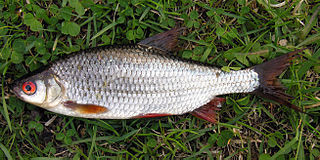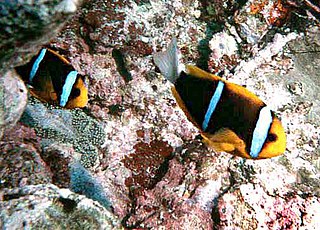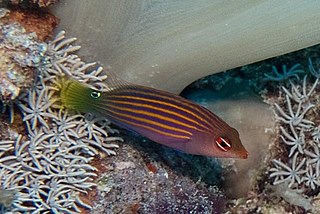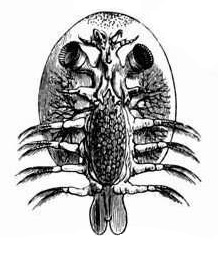Related Research Articles

Copepods are a group of small crustaceans found in nearly every freshwater and saltwater habitat. Some species are planktonic, some are benthic, a number of species have parasitic phases, and some continental species may live in limnoterrestrial habitats and other wet terrestrial places, such as swamps, under leaf fall in wet forests, bogs, springs, ephemeral ponds, and puddles, damp moss, or water-filled recesses (phytotelmata) of plants such as bromeliads and pitcher plants. Many live underground in marine and freshwater caves, sinkholes, or stream beds. Copepods are sometimes used as biodiversity indicators.

The common dace is a species of freshwater and brackish water ray-finned fish from the family Cyprinidae which is native to Europe but which has been introduced to other parts of the world. It is a quarry species for coarse anglers.

The roach, or rutilus roach, also known as the common roach, is a fresh- and brackish-water fish of the family Cyprinidae, native to most of Europe and western Asia. Fish called roach can be any species of the genera Rutilus and Hesperoleucus, depending on locality. The plural of the term is also roach.

The Sacramento blackfish is a species of freshwater fish in central California. A cyprinid, the blackfish is the sole member of its genus.

The orange-fin anemonefish is a marine fish belonging to the family Pomacentridae, the clownfishes and damselfishes, found in the Western Pacific north of the Great Barrier Reef from the surface to 20 m, to include the Pacific Ocean between Queensland, Australia, and New Guinea to the Marshall and Tuamotus Islands. It can grow to 17 cm in length.

The Japanese bullhead shark is a species of bullhead shark in the family Heterodontidae found in the northwestern Pacific Ocean off the coasts of Japan, Korea, and China. This benthic shark occurs at depths of 6–37 m (20–121 ft) over rocky bottoms or kelp beds. Measuring up to 1.2 m (3.9 ft) long, it can be identified by its short, blunt head, two high dorsal fins with anterior spines, and pattern of irregularly shaped, vertical brown bands and stripes. The Japanese bullhead shark is a docile, slow-swimming species that feeds mainly on shelled invertebrates and small bony fishes. Reproduction is oviparous, with females laying spiral-flanged eggs in communal "nests". This species is of little interest to fisheries.

The gray angelfish, also written as grey angelfish and known in Jamaica as the pot cover, is a species of marine ray-finned fish belonging to the marine angelfish family, Pomacanthidae. It is found in the Western Atlantic Ocean.

Elacatinus is a genus of small marine gobies, often known collectively as the neon gobies. Although only one species, E. oceanops, is technically the "neon goby," because of their similar appearance, other members of the genus are generally labeled neon gobies, as well. Except for a single East Pacific species, all reside in warmer parts of the West Atlantic, including the Caribbean and Gulf of Mexico. They are known for engaging in symbiosis with other marine creatures by providing them cleaning service that consists of getting rid of ectoparasites on their bodies. In return, Elacatinus species obtain their primary source of food, ectoparasites.

The six-line wrasse is a species of marine ray-finned fish from the family Labridae which has a wide Indo-Pacific distribution. This species is associated with coral reefs and can be found in the aquarium trade.

The salmon louse is a species of copepod in the genus Lepeophtheirus. It is a sea louse, a parasite living mostly on salmon, particularly on Pacific and Atlantic salmon and sea trout, but is also sometimes found on the three-spined stickleback. It feeds on the mucus, skin and blood of the fish. Once detached, they can be blown by wind across the surface of the sea, like plankton. When they encounter a suitable marine fish host, they adhere themselves to the skin, fins, or gills of the fish, and feed on the mucus or skin. Sea lice only affect fish and are not harmful to humans.

The marlin sucker or spear-fish remora is a species of remora found all over the world in tropical and temperate seas. It can reach up to 40 cm (16 in) in standard length. It normally lives attached to a larger fish; its host preference is for marlins and sailfishes, but it will attach to other large fish.

Branchiura is a group of crustaceans ranked as a subclass of Maxillopoda. Branchiurans are commonly known as fish louse or fish lice if plural.

A sucker in zoology refers to a specialised attachment organ of an animal. It acts as an adhesion device in parasitic worms, several flatworms, cephalopods, certain fishes, amphibians, and bats. It is a muscular structure for suction on a host or substrate. In parasitic annelids, flatworms and roundworms, suckers are the organs of attachment to the host tissues. In tapeworms and flukes, they are a parasitic adaptation for attachment on the internal tissues of the host, such as intestines and blood vessels. In roundworms and flatworms they serve as attachment between individuals particularly during mating. In annelids, a sucker can be both a functional mouth and a locomotory organ. The structure and number of suckers are often used as basic taxonomic diagnosis between different species, since they are unique in each species. In tapeworms there are two distinct classes of suckers, namely "bothridia" for true suckers, and "bothria" for false suckers. In digeneal flukes there are usually an oral sucker at the mouth and a ventral sucker posterior to the mouth. Roundworms have their sucker just in front of the anus; hence it is often called a pre-anal sucker.

Lernaeopodidae is a family of parasitic copepods. The females are typically large and fleshy, and attach to the host permanently using a plug made of chitin called the bulla. The males cling on to the females using their antennae. They parasitize both marine and freshwater fish. Some lernaeopodids, including Clavella and Salmincola, can have negative impacts on fish in aquaculture.
Derilissus is a genus of clingfishes belonging to the family Gobiesocinae found in the western Atlantic Ocean. This family of fish is identified by their appearance as small fish with sucking discs which allow them to attach themselves to various surfaces. Derilissus differs from other genera due to its attached gill membranes.
Pennella balaenopterae is a large ectoparasitic copepod specialising in parasitising marine mammals. It is the largest member of the genus Pennella, the other species of which are parasites of larger marine fish.

Argulus foliaceus is a species of crustaceans in the family Argulidae, the fish lice. It is sometimes called the common fish louse. It is "the most common and widespread native argulid in the Palaearctic" and "one of the most widespread crustacean ectoparasites of freshwater fish in the world", considering its distribution and range of hosts. It can cause the severe disease state argulosis in a wide variety of fish species. It is responsible for epizootic outbreaks that have led to the collapse of aquaculture operations. Fish lice are not related to lice, which are insects.

Lepeophtheirus pectoralis is a species of parasitic copepod from the northeast Atlantic Ocean, and the type species of the genus Lepeophtheirus. It is a parasite of flatfish, with the European flounder, the plaice, and the dab as the most frequent hosts. It feeds on the mucus, skin, and blood of the fish, with egg-producing females infecting the pectoral and pelvic fins of the host, while immature individuals and males are found on the rest of the body.
Gyrodactylus turnbulli is an ectoparasite from the class Monogenea, is part of the phylum Platyhelminthes, and from the genus Gyrodactylus. It only requires one host to transmit an infection; however, since this parasite lacks oncomiracidium, it must rely on either the adult or subadult for spread of infection. Found in freshwater, this flatworm is commonly found on the gills and fins of the guppy, Poecilia reticulata. G. turnbulli was said to be host specific, but an experiment where parasitologists artificially infected guppies suggests that the parasite can infect a wider range of species. This ability is achievable by host switching, which promotes speciation.

Hydrichthys sarcotretis is a species of colonial marine hydrozoans now included in the family Pandeidae. The polyps of members of this genus are parasitic and attach themselves to a fish. H. sarcotretis is a species that exhibits hyperparasitism by attaching itself to a copepod, itself the parasite of a fish.
References
- 1 2 "Tracheliastes polycolpus Nordmann, 1832". World of Copepods database. World Register of Marine Species. 2022. Retrieved 26 April 2022.
- 1 2 3 4 5 Loot, Geraldine; Nicolas Poulet; Yorick Reyjol; Simon Blanchet & Sovan Lek (2004). "The effects of the ectoparasite Tracheliastes polycolpus (Copepoda: Lernaeopodidae) on the fins of rostrum dace (Leuciscus leuciscus burdigalensis)". Parasitology Research . 94 (1): 16–23. doi:10.1007/s00436-004-1166-9.
- 1 2 Blanchet, Simon; Rey, Olivier; Loot, Geraldine (2010). "Evidence for host variation in parasite tolerance in a wild fish population". Evolutionary Ecology. 24 (5): 1129–1139. doi:10.1007/s10682-010-9353-x.
- ↑ "Tracheliastes polycolpus baicalensis Messjatzeff, 1928". World of Copepods database. World Register of Marine Species. 2022. Retrieved 26 April 2022.